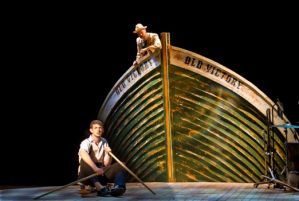Swallows and Amazons, Bristol Old Vic | reviews, news & interviews
Swallows and Amazons, Bristol Old Vic
Swallows and Amazons, Bristol Old Vic
A delightful Christmas musical feeds off the power of childish imagination

Swallows and Amazons is a quintessentially English story: a heart-warming hymn to decent values, the codes of sailing and the youthful spirit of adventure. Set in 1929, at a time when the country faced financial meltdown, it is perhaps not surprising, in our equally uncertain times, that Arthur Ransome’s feelgood Lakeland classic should have been adapted for the stage.
The original book, about a group of kids who mess about with boats and allow their fantasies to run free and weave a captivating narrative of noble seafarers and dastardly pirates, derives its magic from the imagination-fuelled way in which children play. The universe of make-believe they create is at odds with the humdrum reality imposed by parents, the “Barbarians”, as they call them, no longer capable of dreaming and blind to the rich and magical world around them.
This production plays strongly to this essential aspect of Ransome’s world, exploiting with a marvellous sense of invention all the possibilities of a theatrical experience where the audience plays along with the cast in imagining the unfolding of the show: boats, water, reeds are all conjured with the minimum of physical props, in the manner made familiar by those trained by Jacques Lecoq – from Complicite to Robert Lepage.
The sound effects, too, are startling – from an invisible but very tangible campfire evoked by a miniature symphony of finger-snapping and handclaps, to the sound of water lapping against a boat-side produced in a large water bottle. And yet, there is at times something a little laboured in this purposeful evocation of the imagination – almost as if the company were trying too hard to sell us the power of “as if”. There is real brio here, but it occasionally feels just a little bit clunky, though I suspect that the children in the audience don’t mind at all. The story’s Englishness is strongly reflected in the contrast between the two main groups of protagonists: the awfully nice Swallows (the Walker family) led by Cap’n John, ably played as officer material by Stuart McLoughlin, and a crew including prim Susan (Rosalie Craig) who is always worried that “mother wouldn’t like it”, Roger, the youngest, played to good and comical effect by a relatively large actor, Stewart Right, and last but certainly not least, Titty Walker whose effervescence is rendered with great panache by Akiya Henry (pictured above), a charismatic actress and singer who very nearly steals the show.
The story’s Englishness is strongly reflected in the contrast between the two main groups of protagonists: the awfully nice Swallows (the Walker family) led by Cap’n John, ably played as officer material by Stuart McLoughlin, and a crew including prim Susan (Rosalie Craig) who is always worried that “mother wouldn’t like it”, Roger, the youngest, played to good and comical effect by a relatively large actor, Stewart Right, and last but certainly not least, Titty Walker whose effervescence is rendered with great panache by Akiya Henry (pictured above), a charismatic actress and singer who very nearly steals the show.
The Amazons are the rebels of the piece: while the Swallows are playing at being future members of the establishment, the Blackett sisters strut around like proto-punks, keen to shock with shows of violence and bad behaviour. Celia Adams as Nancy plays the part forcefully though her performance is a little one-dimensional until the vulnerability beneath her brash exterior becomes apparent in the latter part of the show.
This is very much an ensemble piece: the less central roles are taken by actors who also play musical instruments, produce a variety of sound effects and handle the minimal props which evoke the sailing boats, scenery, a variety of wild fowl (including a menacing cormorant) and other elements of the imaginative whole which goes through an endless series of eye-catching mutations. Hannon's songs work well as vehicles for the lead actors, not least to underscore the show of strength from the Blackett sisters – decked out in costumes that evoke the Girl Guides as much as tribespeople from the Amazon basin - but also expressing the richness and complexity of individual characters: John Walker has a poetic side reflected in a song about the darkness falling over the lake, and Titty’s solo spot reveals something deeper than the ebullience which mostly defines her.  In the finale, Robert Innes Hopkins’s skills as a designer finally become fully apparent: with Captain Flint’s large boat “Old Victory” dominating the stage (pictured left), there is a fitting and rambunctious climax, with much song and dance and some engaging audience participation – allowing the children and child-spirited members of the audience to hurl foam projectiles at the beleaguered Flint, and to perilously carry over their heads, body-surfing style, two beautiful models of the Swallow and Amazon, launched by the company as a kind of gift to the audience. The end of the story sees the imagination and the world of children vindicated, as the grown-ups recognise the reality of the fantasy world that has been played out across the lake and its islands. What is never clear, and it is right that it should remain so, is whether this transformation of the “Barbarians” into playmates is itself no more than yet another act in the children’s effortless games of make-believe.
In the finale, Robert Innes Hopkins’s skills as a designer finally become fully apparent: with Captain Flint’s large boat “Old Victory” dominating the stage (pictured left), there is a fitting and rambunctious climax, with much song and dance and some engaging audience participation – allowing the children and child-spirited members of the audience to hurl foam projectiles at the beleaguered Flint, and to perilously carry over their heads, body-surfing style, two beautiful models of the Swallow and Amazon, launched by the company as a kind of gift to the audience. The end of the story sees the imagination and the world of children vindicated, as the grown-ups recognise the reality of the fantasy world that has been played out across the lake and its islands. What is never clear, and it is right that it should remain so, is whether this transformation of the “Barbarians” into playmates is itself no more than yet another act in the children’s effortless games of make-believe.
- Swallows and Amazons at Bristol Old Vic until 15 January, 2011
- Find Arthur Ransome's Swallows and Amazons on Amazon
Buy
Share this article
Add comment
The future of Arts Journalism
You can stop theartsdesk.com closing!
We urgently need financing to survive. Our fundraising drive has thus far raised £49,000 but we need to reach £100,000 or we will be forced to close. Please contribute here: https://gofund.me/c3f6033d
And if you can forward this information to anyone who might assist, we’d be grateful.

Subscribe to theartsdesk.com
Thank you for continuing to read our work on theartsdesk.com. For unlimited access to every article in its entirety, including our archive of more than 15,000 pieces, we're asking for £5 per month or £40 per year. We feel it's a very good deal, and hope you do too.
To take a subscription now simply click here.
And if you're looking for that extra gift for a friend or family member, why not treat them to a theartsdesk.com gift subscription?
more Theatre
 Othello, Theatre Royal, Haymarket review - a surprising mix of stateliness and ironic humour
David Harewood and Toby Jones at odds
Othello, Theatre Royal, Haymarket review - a surprising mix of stateliness and ironic humour
David Harewood and Toby Jones at odds
 Macbeth, RSC, Stratford review - Glaswegian gangs and ghoulies prove gripping
Sam Heughan's Macbeth cannot quite find a home in a mobster pub
Macbeth, RSC, Stratford review - Glaswegian gangs and ghoulies prove gripping
Sam Heughan's Macbeth cannot quite find a home in a mobster pub
 The Line of Beauty, Almeida Theatre review - the 80s revisited in theatrically ravishing form
Alan Hollinghurst novel is cunningly filleted, very finely acted
The Line of Beauty, Almeida Theatre review - the 80s revisited in theatrically ravishing form
Alan Hollinghurst novel is cunningly filleted, very finely acted
 Wendy & Peter Pan, Barbican Theatre review - mixed bag of panto and comic play, turned up to 11
The RSC adaptation is aimed at children, though all will thrill to its spectacle
Wendy & Peter Pan, Barbican Theatre review - mixed bag of panto and comic play, turned up to 11
The RSC adaptation is aimed at children, though all will thrill to its spectacle
 Hedda, Orange Tree Theatre review - a monument reimagined, perhaps even improved
Scandinavian masterpiece transplanted into a London reeling from the ravages of war
Hedda, Orange Tree Theatre review - a monument reimagined, perhaps even improved
Scandinavian masterpiece transplanted into a London reeling from the ravages of war
 The Assembled Parties, Hampstead review - a rarity, a well-made play delivered straight
Witty but poignant tribute to the strength of family ties as all around disintegrates
The Assembled Parties, Hampstead review - a rarity, a well-made play delivered straight
Witty but poignant tribute to the strength of family ties as all around disintegrates
 Mary Page Marlowe, Old Vic review - a starry portrait of a splintered life
Tracy Letts's Off Broadway play makes a shimmeringly powerful London debut
Mary Page Marlowe, Old Vic review - a starry portrait of a splintered life
Tracy Letts's Off Broadway play makes a shimmeringly powerful London debut
 Little Brother, Soho Theatre review - light, bright but emotionally true
This Verity Bargate Award-winning dramedy is entertaining as well as thought provoking
Little Brother, Soho Theatre review - light, bright but emotionally true
This Verity Bargate Award-winning dramedy is entertaining as well as thought provoking
 The Unbelievers, Royal Court Theatre - grimly compelling, powerfully performed
Nick Payne's new play is amongst his best
The Unbelievers, Royal Court Theatre - grimly compelling, powerfully performed
Nick Payne's new play is amongst his best
 The Maids, Donmar Warehouse review - vibrant cast lost in a spectacular-looking fever dream
Kip Williams revises Genet, with little gained in the update except eye-popping visuals
The Maids, Donmar Warehouse review - vibrant cast lost in a spectacular-looking fever dream
Kip Williams revises Genet, with little gained in the update except eye-popping visuals
 Ragdoll, Jermyn Street Theatre review - compelling and emotionally truthful
Katherine Moar returns with a Patty Hearst-inspired follow up to her debut hit 'Farm Hall'
Ragdoll, Jermyn Street Theatre review - compelling and emotionally truthful
Katherine Moar returns with a Patty Hearst-inspired follow up to her debut hit 'Farm Hall'
 Troilus and Cressida, Globe Theatre review - a 'problem play' with added problems
Raucous and carnivalesque, but also ugly and incomprehensible
Troilus and Cressida, Globe Theatre review - a 'problem play' with added problems
Raucous and carnivalesque, but also ugly and incomprehensible

Comments
...